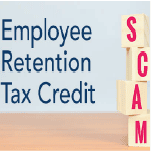 The airwaves and internet are inundated these days with advertisements claiming that businesses are missing out on the lucrative Employee Retention Tax Credit (ERTC). While some employers do indeed remain eligible if they meet certain criteria, the IRS continues to caution businesses about third-party scams related to the credit.
The airwaves and internet are inundated these days with advertisements claiming that businesses are missing out on the lucrative Employee Retention Tax Credit (ERTC). While some employers do indeed remain eligible if they meet certain criteria, the IRS continues to caution businesses about third-party scams related to the credit.
While there’s nothing wrong with claiming credits you’re entitled to, those that claim the ERTC improperly could find themselves in hot water with the IRS and face cash-flow problems as a result. Here’s what you need to know to reduce your risks.
ERTC in a Nutshell
The ERTC is a refundable tax credit intended for businesses that 1) continued paying employees while they were shut down due to the pandemic in 2020 and 2021, or 2) suffered significant declines in gross receipts from March 13, 2020, to December 31, 2021. Eligible employers could receive credits worth up to $26,000 per retained employee. The credit may still be available on an amended tax return.
The requirements are strict, though. Specifically, you must have:
- Sustained a full or partial suspension of operations due to orders from a governmental authority that limited commerce, travel or group meetings due to COVID-19 during 2020 or the first three quarters of 2021,
- Experienced a significant decline in gross receipts during 2020 or in the first three quarters of 2021, or
- Qualified as a recovery startup business — which can claim the credit for up to $50,000 total per quarter without showing suspended operations or reduced receipts — for the third or fourth quarters of 2021. (Qualified recovery startups are those that began operating after February 15, 2020, and have annual gross receipts of less than or equal to $1 million for the three tax years preceding the quarter for which they are claiming the ERTC.)
In addition, a business can’t claim the ERTC on wages that it reported as payroll costs when it applied for Paycheck Protection Program (PPP) loan forgiveness or it used to claim certain other tax credits. Also, a business must reduce the wage deductions claimed on its federal income tax return by the amount of credits.
Prevalence of Scams
The potentially high value of the ERTC, combined with the fact that employers can file claims for it on amended returns until April 15, 2025, has led to a cottage industry of fraudulent promoters offering to help businesses claim the credit. These fraudsters wield inaccurate information and inflated promises to generate business from innocent clients. In return, they reap excessive upfront fees in the thousands of dollars or commissions as high as 25% of the refund received.
The IRS has called the amount of misleading marketing around the credit “staggering.” For example, in recent guidance, the tax agency explained that, contrary to advice given by some promoters, supply chain disruptions generally don’t qualify an employer for the credit unless the disruptions were due to a government order. It’s not enough that an employer suspended operations because of disruptions — the credit applies only if the employer had to suspend operations because a government order caused the supplier to suspend its operations.
ERTC fraud has grown so serious that the IRS has included it in its annual “Dirty Dozen” list of the worst tax scams in the country. In Utah, for example, the U.S. Department of Justice has charged two promoters, who did business as “1099 Tax Pros,” with participating in a fraudulent tax scheme by preparing and submitting more than 1,000 forms to the IRS. They claimed more than $11 million in false ERTCs and COVID-related sick and family leave wage credits for their clients.
Fraudsters have been able to monopolize on the general confusion and uncertainty around the ERTC. A recent congressional hearing found that some of the problems can be traced back to the entirely paper application process created for the credit. This has contributed to a backlog of nearly 500,000 unprocessed claims, out of more than 2.5 million claims that have been submitted.
Although it’s unclear how much progress the IRS has made on the backlog, the agency has announced that it has entered a new phase of intensified scrutiny of ERTC claims. It’s stepping up its compliance work and establishing additional procedures to deal with fraud in the program. The IRS already has increased its audit and criminal investigation work on ERTC claims, focusing on both the promoters and the businesses filing dubious claims.
If you fell into the trap and are among those businesses, you could end up on the hook for repayment of the credit, along with penalties and interest, on top of the fees you paid the promoter. That could make a substantial dent in your cash flow.
Even if you’re eligible for the credit, you could run into trouble if you failed to reduce your wage deductions accordingly or claimed it on wages that you also used to claim other credits. As the IRS has noted, promoters may leave out key details, unleashing a “domino effect of tax problems” for unsuspecting businesses.
Moreover, providing your business and tax documents to an unscrupulous promoter could put you at risk of identify theft.
Red Flags to Watch For
The IRS has identified several warning signs of illegitimate promoters, including:
- Unsolicited phone calls, text messages, direct mail or ads highlighting an “easy application process” or a short eligibility checklist (the rules for eligibility and computation of credit amounts are actually quite complicated),
- Statements that the promoter can determine your ERTC eligibility within minutes,
- Hefty upfront fees,
- Fees based on a percentage of the refund amount claimed,
- Preparers who refuse to sign the amended tax return filed to claim a refund of the credit,
- Aggressive claims from the promoter that you qualify before you’ve discussed your individual tax situation (the credit isn’t available to all employers), or
- Refusal to provide detailed documentation of how your credit was calculated.
The IRS also warns that some ERTC “mills” are sending out fake letters from nonexistent government entities such as the “Department of Employee Retention Credit.” The letters are designed to look like official IRS or government correspondence and typically include urgent language pushing immediate action.
Protect Yourself
Taking several simple steps can help you cut your risk of being victimized by scammers. First, if you think you may qualify for the credit, work with a trusted professional — one who isn’t proactively soliciting ERTC work. Those who are aggressively marketing the credit (and in some cases, only the credit) are more interested in making money themselves and are unlikely to prioritize or protect your best interests.
You also should request a detailed worksheet that explains how you’re eligible for the credit. The worksheet should “show the math” for the credit amount as well.
If you’re claiming you suspended business due to a government order, ensure that you have legitimate documentation of the order. Don’t accept a generic document about a government order from a third party. Rather, you should acquire a copy of the actual government order and review it to confirm that it applies to your business.
Proceed with Caution
No taxpayer ever wants to leave money on the IRS’s table, but skepticism is warranted whenever something seems too good to be true. If you believe your business might be eligible for the ERTC, we can help you verify eligibility, compute your credit and file your refund claim. We can also help you determine how to proceed if you claimed the ERTC improperly.
